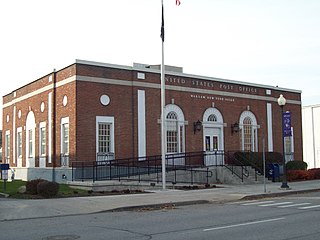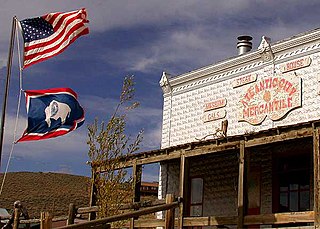
The Jackson Hole American Legion Post No. 43 is a log building in Jackson, Wyoming, home to the local post of the American Legion. The post was built in 1928-29 and functioned as a community center. During its period of significance from 1929 to 1953 the post was instrumental in the shift of economic and political interests in Jackson Hole from a rural emphasis to urban interests.
The UXU Ranch is a historic dude ranch in Shoshone National Forest near Wapiti, Wyoming. The ranch began as a sawmill, as early as 1898. In 1929 Bronson Case "Bob" Rumsey obtained a permit from the U.S. Forest Service to operate a dude ranch on the property, using the sawmill headquarters building, a lodge, and tent cabins. Most of the current structures were built in the 1920s and 1930s from lumber milled on the site.

The Yellowstone Main Post Office in Yellowstone National Park was built in Mammoth Hot Springs as part of a facilities improvement program by the United States Post Office Department (USPOD). The post office in Yellowstone was nominated to the National Register of Historic Places as part of a thematic study comprising twelve Wyoming post offices built to standardized USPOD plans in the early twentieth century. The Yellowstone facility is an understated classical structure with a low hipped roof and rounded dormers that uses a plan and a basic design vocabulary similar to that used in other post offices in the program. However it also includes restrained French Renaissance Revival elements, the only post office in the western United States to merge these two styles.It is somewhat at odds with the prevailing design theme expressed in other buildings in the former Fort Yellowstone district. The Yellowstone Main Post Office is also a contributing property to the Mammoth Hot Springs Historic District.

The Basin Main Post Office in Basin, Wyoming was built in 1919 as part of a facilities improvement program by the United States Post Office Department. The post office in Basin was nominated to the National Register of Historic Places as part of a thematic study comprising twelve Wyoming post offices built to standardized USPO plans in the early twentieth century.

The Newcastle Main Post Office is a historic post office building in Newcastle, Wyoming. Built in 1932, it was constructed as part of a facilities improvement program by the United States Post Office Department. The post office in Newcastle was nominated to the National Register of Historic Places as part of a thematic study comprising twelve Wyoming post offices built to standardized USPO plans in the early twentieth century.

The Anderson Lodge or Anderson Studio was built in 1890 in the Absaroka Mountains west of Meeteetse, Wyoming, in what was then the Yellowstone Park Timber Land Reserve, soon renamed the Yellowstone Forest Reserve. The two-story rustic log structure became the home of rancher and artist Abraham Archibald Anderson from 1901 to 1905. Anderson played a significant role in the development of the forest reserve as Special Superintendent of Forest Reserves, and the Anderson Lodge was used as an administrative building for the forest.

This is a list of the National Register of Historic Places listings in Big Horn County, Wyoming.

This is a list of the National Register of Historic Places listings in Campbell County, Wyoming. It is intended to be a complete list of the properties and districts on the National Register of Historic Places in Campbell County, Wyoming, United States. The locations of National Register properties and districts for which the latitude and longitude coordinates are included below, may be seen in a map.
The Fort Laramie Three-Mile Hog Ranch was built to serve as a social center away from the soldiers' post at historic Fort Laramie. Fort Laramie was a 19th-century military post in eastern Wyoming. It became notorious as a place for gambling and drinking, and for prostitution, with at least ten prostitutes always in residence. The location is notable as an example of one of only a few military bordellos still standing in the United States by 1974, the time of its nomination to the National Register of Historic Places The Fort Laramie site was one of a number of so-called "hog ranches" that appeared along trails in Wyoming.

US Post Office—Attica is a historic post office building located at Attica in Wyoming County, New York. It was designed and built in 1936-1937 as a Works Progress Administration project, and is one of a number of post offices in New York State designed by the Office of the Supervising Architect of the Treasury Department, Louis A. Simon. It is a one-story brick structure on a stone watertable in the Colonial Revival style. The interior includes a mural painted in 1938 by Thomas Donnelly and titled Fall in the Genesee Country.

US Post Office-Warsaw is a historic post office building located at Warsaw in Wyoming County, New York. It was designed and built in 1934-1935 as a Works Progress Administration project, and is one of a number of post offices in New York State designed by the Office of the Supervising Architect of the Treasury Department, Louis A. Simon. It is a one-story, five bay steel frame brick structure on a raised reinforced concrete foundation in the Colonial Revival style.

The Uinta County Courthouse in Evanston, Wyoming is the oldest courthouse building in Wyoming, and one of the oldest permanent structures in Wyoming. Built in three stages, the first phase was a two-story jail, built in 1873. It was expanded with court facilities the following year, and in 1910 the main portion of the Georgian Revival structure was built with the present façade. Each phase showed an increasing attention to detail and ornament.

Wyoming Mercantile, also known as the Aladdin General Store is a preserved small-town general store in Aladdin, Wyoming. The store, which remains in operation, was built in 1896 by Amos Robinson as Wyoming Mercantile. Robinson died the same year, and the store went to Mahlon S. Kemmerer, who placed his properties, including the Wyoming and Missouri Valley Railroad, under the Wyoming Mercantile umbrella. Railroading continued until 1927. The store has continued, serving as a post office, bar, freight station and gas station.

The Daniel School was built in Daniel, Wyoming by contractor A.F. Atwood in 1920. The rural school served Daniel and its surrounding area, replacing improvised school facilities. In 1939, the Daniel district was consolidated, and students were bused to Pinedale for classes. Following consolidation, the Daniel School stood empty until the Daniel Homemaker Club acquired and renovated the building. It is a representative of a typical one-room schoolhouse from the early 20th century, and it has been the object of field trips by classes seeking to experience the historical learning environment.

US Post Office-Garden City is a historic post office building located at Garden City in the town of Hempstead, Nassau County, New York, United States. It was built in 1936 and designed by consulting architects Walker & Gillette for the Office of the Supervising Architect. It is a one-story, square brick building on a granite in the Classical Revival style. The lobby features a 1937 mural by J. Theodore Johnson titled "Huckleberry Frolic." On December 24, 1987, the building was named in honor of former Congressman John W. Wydler (1924-1987).

Atlantic City Mercantile is a former store now used as a bar and restaurant in Atlantic City, Wyoming. It is one of the chief buildings in the small mining town in the South Pass area of Wyoming, and is a significant example of a late 19th-century commercial building on what had recently been the frontier.

Granger Station State Historic Site, also known as Granger Stage Station, South Bend Station and Ham's Fork Station, is a state park in Granger, Wyoming, United States, that is listed on the National Register of Historic Places (NRHP).

Michigan City Post Office is a historic post office building located at Michigan City, LaPorte County, Indiana. It was designed by the Office of the Supervising Architect under James Knox Taylor and built in 1909. It is a one-story, Georgian Revival style brick and limestone building. It has a hipped roof behind a balustraded parapet and basement. A rear addition was built in 1926, and expanded in 1963. It housed a post office until 1973.

The First National Bank of Rock River was built in 1919 in the small community of Rock River, Wyoming, at the peak of a local oil boom and operated from February 1920. The bank closed its doors on April 11, 1923 as the oil boom collapsed and its vice president was convicted of embezzlement. The bank went into receivership on June 14, 1923 and its building sold to the new Citizen's State Bank, but was claimed by Albany County for back taxes in 1931. In 1936 the county sold the building to the town. It became a civic center for the town, operating a post office until the 1950s. A doctor's office had occupied the rear in the 1920s, and in the 1940s apartments were built, which later became the town's jail. With the departure of the post office the building became a fire station. From 1935 to 1985 the Council Room was used by civic organizations. From 1940 to 1985 another room was the town library.

The Stockgrowers Bank, also known as the Dixon Town Hall, was built in Dixon, Wyoming in 1916. The decorated concrete masonry building was the bank's headquarters until the bank was dissolved in 1923. Following the bank's demise the building served as a soda fountain into the 1940s, which was followed by a store, then the Little Snake River Veterans of Foreign Wars Post 10051 hall. In 1975 it became the town hall.





















